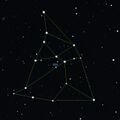Coma Berenices: Difference between revisions
From All Skies Encyclopaedia
Coma Berenices
No edit summary |
|||
| Line 12: | Line 12: | ||
== Names of the Star Cluster in other cultures == |
== Names of the Star Cluster in other cultures == |
||
# Aldafirah (Arabic - translation from Greek) |
|||
# [[Awarhakoya]] (Locono People, South America) |
# [[Awarhakoya]] (Locono People, South America) |
||
# [[Fatana-lua]] (..., Tonga/ Polynesia) |
# [[Fatana-lua]] (..., Tonga/ Polynesia) |
||
# Hulbatalasad (Arabic Indigenous) |
|||
# [[Itua ni Bure]] (..., Gilbert Is./ Micronesia) |
# [[Itua ni Bure]] (..., Gilbert Is./ Micronesia) |
||
# [[Kinallaúb|Kinallaub]] (Kankanaey People, Philippines) |
# [[Kinallaúb|Kinallaub]] (Kankanaey People, Philippines) |
||
Revision as of 13:33, 12 July 2024

photograph of the Coma star cluster. This file is from Wikimedia Commons and may be used by other projects. Open cluster Melotte 111, or Coma Star Cluster. http://sternwarte-kempten.de/
One of the 88 IAU constellations. The ancient "Greek" constellation originates from Egypt. It has been invented by Konon, the royal astronomer of king Ptolemy III and it was named after his wife, Queen Berenice II Euergetis as reported by Eratosthenes. However, the asterism always used to have names in other cultures. In this area of the sky close the pole of the ecliptic, there are not many bright stars, but a clearly recognizable star cluster of triangular shape (the visual appearance is an isosceles triangle).
Etymology and History
Origin of Constellation
Transfer and Transformation of the Constellation
Greek Mythology
Names of the Star Cluster in other cultures
- Aldafirah (Arabic - translation from Greek)
- Awarhakoya (Locono People, South America)
- Fatana-lua (..., Tonga/ Polynesia)
- Hulbatalasad (Arabic Indigenous)
- Itua ni Bure (..., Gilbert Is./ Micronesia)
- Kinallaub (Kankanaey People, Philippines)
- Langwei (郎位) (Chinese)
- Sissinnu (Akkadian/Babylonian)
Images from different cultures










